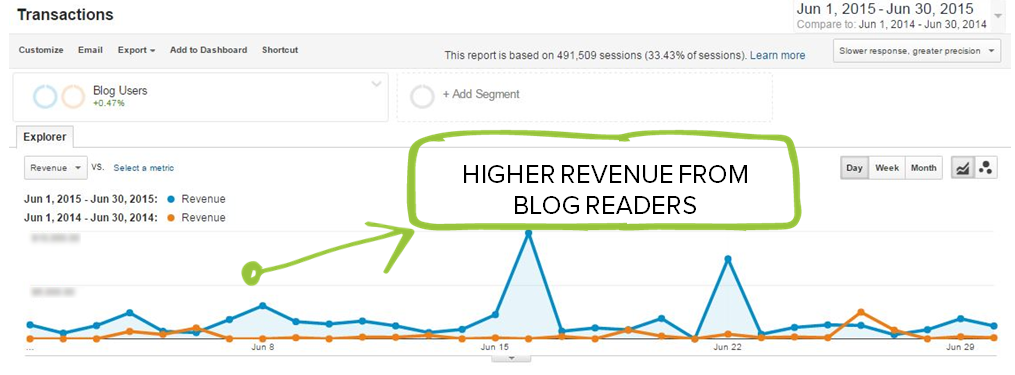Industry: Ecommerce
Content: Blog articles
Highlights: More revenue, Bigger audience, Higher keyword rankings
Retailers are being forced to change the way they do business. People search first when they’re looking to make a purchase and over 80 percent research products online before making a decision. This change is making them dedicate more resources toward web marketing so they can stand out when consumers search for products, and a competitive blog strategy was the differentiator that got a specialty retailer 5x more revenue in a year.

It’s not a matter of customer loyalty or convenience when the same products are available (often for less) at the click of a button. It’s a matter of being there with the most relevant information at the right time. This is where SEO strategies and content marketing come into play as a way to stand out.
Getting a foot in the door with shoe buyers
A specialty shoe brand that has always performed well in offline sales knew it needed to break into the online marketplace to stay competitive. With a specialty product, the team understood there were important opportunities to educate customers that a content marketing strategy could fulfill.
We partnered with the company to create custom content that would inform the brand’s target audience about the need for its products, but additionally:
- Build the brand’s search presence (SEO)
- Get more people to its ecommerce site where they can browse and buy shoes (Drive conversions)
- Engage readers by speaking about how they fit into a specific lifestyle (walk a mile in their shoes)
After a year of consistently producing original content across top product categories, it was clear the strategy was paying off. Comparing data from 2015 to 2014, the website was seeing:
- 6.5x growth in blog readers
- 6x more purchases from blog readers
- 5x the revenue from blog readers
Marketing results that grow with your content strategy
The results this company has seen look impressive, and they are. But here’s a harsh truth: You’re not going to be an overnight success with content marketing. Organic web marketing strategies, like content creation, usually take time to build momentum.
It’s not a question of producing high-quality content, or whether your product is compelling or even how much you spend promoting it. The fact of the matter is, content marketing is most effective when there’s a lot of momentum behind it. This is especially true in a crowded marketplace like retail.
To stand out, a company needs to publish better content, more consistently than its competitors. And that’s exactly what we helped this shoe brand achieve with a long-term content marketing strategy. Here’s how we did it:
1. Build a content archive around top product categories
We worked with the client to break its customer base into categories based on the products they purchase. For instance:
- Group A is mostly made up of health care workers and they purchase shoes for that professional environment. For these readers, we create content that speaks to their on-the-job challenges and how products designed for them can solve common pain points.
- Group B is mostly made up of boating enthusiasts who purchase shoes they can safely wear onboard. For these readers, we create content that talks about boat maintenance and how having the right apparel can improve their experiences.
What we found was that the website was getting the most traffic to categories that had the most content. It was evident that freshness mattered in search results, and topics that received the most coverage were also getting more visibility and driving traffic back to the website.
The takeaway: When you’re creating a content marketing strategy, first focus on the categories that are most important to your bottom line. Make sure these are getting plenty of coverage so they gain visibility in search results and drive traffic to your brand.
2. Distribute content across channels
Another element of our client’s success was the way it distributed the blog content. Rather than publishing the articles on the blog and hoping readers would find them, the brand’s marketing team distributed them across social media and directly to customers in email blasts. These additional efforts ensured the content was reaching the intended audience and driving value for the business.
The takeaway: Don’t count on customers finding your content. Get the information in front of your target audience by pushing it out on the channels they use and making it easy for them to find.
3. Outrank competitors and drive traffic to the site
In the process of building an archive of content that’s built around customers’ questions and relevant to the brand’s products, we also improved the company’s search presence. It recently overtook its competitors in search results and since then, it’s consistently ranked above those other sites in SERPs.

The takeaway: Create content that’s relevant to your products (and the search terms you want to rank for), but isn’t focused on keywords. Google is looking at context to evaluate how well content answers’ searchers’ questions. By building an archive of assets around their queries, you can build stronger search signals to rank higher in results pages.
A content marketing strategy helped this shoe company transition from an offline brand to an online competitor. It established a search presence, engaged with prospective customers who were looking for solutions and showed them why it’s the best in the biz. Combined, these marketing wins have created a new revenue stream for this retail brand where there wasn’t one before, and that’s how businesses survive and thrive in the face of evolving buyer behavior.





